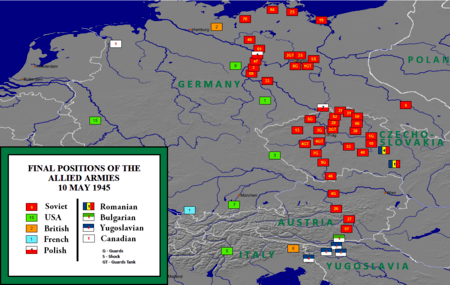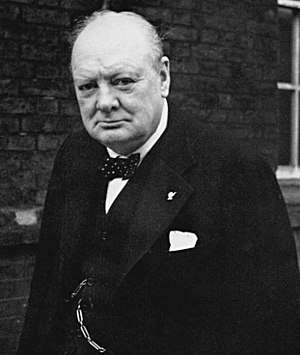Operation Unthinkable

Operation Unthinkable was a code name of two related, unrealised plans by the Western Allies against the Soviet Union. They were ordered by British Prime Minister Winston Churchill in 1945 and developed by the British Armed Forces' Joint Planning Staff at the end of World War II in Europe.
The first of the two assumed a surprise attack on the Soviet forces stationed in Germany in order to "impose the will of the Western Allies" on the Soviets. "The will" was qualified as "square deal for Poland"[1] (which probably meant enforcing the recently signed Yalta Agreement). When the odds were judged "fanciful", the original plan was abandoned. The code name was used instead for a defensive scenario, in which the British were to defend against a Soviet drive towards the North Sea and the Atlantic following the withdrawal of the American forces from the continent.
The study became the first Cold War-era contingency plan for war with the Soviet Union.[2] Both plans were highly secret at the time of their creation and it was not until 1998 that they were made public,[3] although the British spy for the Soviets, Guy Burgess, had passed on some details at the time.
Operations
Offensive
The initial primary goal of the operation was declared as "to impose upon Russia the will of the United States and the British Empire. Even though 'the will' of these two countries may be defined as no more than a square deal for Poland, that does not necessarily limit the military commitment".[1] The word "Russia" is used heavily throughout the document, as during the Imperial period the term was used to refer to the Russian Empire, with which the USSR was almost coextensive.
The chiefs of staff were concerned that given the enormous size of Soviet forces deployed in Europe at the end of the war, and the perception that the Soviet leader Joseph Stalin was unreliable, there existed a Soviet threat to Western Europe. The Soviet Union had yet to launch its attack on Japanese forces, and so one assumption in the report was that the Soviet Union would instead ally with Japan if the Western Allies commenced hostilities.
The hypothetical date for the start of the Allied invasion of Soviet-held Europe was scheduled for 1 July 1945, four days before the UK general election.[4] The plan assumed a surprise attack by up to 47 British and American divisions in the area of Dresden, in the middle of Soviet lines.[4] This represented almost half of the roughly 100 divisions available to the British, American and Canadian headquarters at that time.[3]
The plan was taken by the British Chiefs of Staff Committee as militarily unfeasible due to an anticipated 2.5 to 1 superiority in divisions of Soviet land forces in Europe and the Middle East by 1 July, where the conflict was projected to take place.[5] The majority of any offensive operation would have been undertaken by American and British forces, as well as Polish forces and up to 100,000 German Wehrmacht soldiers. Any quick success would be due to surprise alone. If a quick success could not be obtained before the onset of winter, the assessment was that the Allies would be committed to a protracted total war. In the report of 22 May 1945, an offensive operation was deemed "hazardous".
| Allied | Soviet[6] | ||||||
|---|---|---|---|---|---|---|---|
| W. Europe | Italy | Total | Operational Forces | STAVKA Reserve | Total | Ratio | |
| Manpower | 5,077,780[7][lower-alpha 2] | 1,333,856[8] | 6,411,636 | 6,750,149 | 431,838 | 7,181,987 | 1.12 : 1 |
| Tanks and Assault Guns[lower-alpha 3] | c. 19,100[9][lower-alpha 4][lower-alpha 5] | 3,100[10] | 22,200 | 12,333[lower-alpha 6] | 324[lower-alpha 7] | 12,657 | 1.75 : 1 |
| Artillery | c. 63,000[11] | 10,200[12] | c. 70,200 | 114,344[lower-alpha 8] | 6,838[lower-alpha 9] | 121,182 | 1.73 : 1 |
| Combat Aircraft | 28,000[13][lower-alpha 10] | 4,000[14] | 32,000 | 18,823[lower-alpha 11] | 624[lower-alpha 12] | 19,447 | 1.65 : 1 |
| Motor Vehicles | 970,000[15] | unknown | unknown | 366,959[lower-alpha 13] | 20,362[lower-alpha 14] | 387,321 | over 2.5 : 1 |
| Allied | Soviet | Ratio | |
|---|---|---|---|
| Infantry Divisions[lower-alpha 15] | 80 | 228 | 2.85 : 1 |
| Armored Divisions[lower-alpha 16] | 23 | 36 | 1.57 : 1 |
| Tactical Aircraft | 6,048[lower-alpha 17] | 11,802 | 1.95 : 1 |
| Strategic Aircraft | 2,750[lower-alpha 18] | 960 | 2.86 : 1 |
Defensive
In response to an instruction by Churchill of 10 June 1945, a follow-up report was written concerning "what measures would be required to ensure the security of the British Isles in the event of war with Russia in the near future".[17] United States forces were relocating to the Pacific for a planned invasion of Japan, and Churchill was concerned that this reduction in supporting forces would leave the Soviets in a strong position to take offensive action in Western Europe. The report concluded that if the United States focused on the Pacific Theatre, Great Britain's odds "would become fanciful."[18]
The Joint Planning Staff rejected Churchill's notion of retaining bridgeheads on the continent as having no operational advantage. It was envisaged that Britain would use its air force and navy to resist, although a threat from mass rocket attack was anticipated, with no means of resistance except for strategic bombing.
Subsequent discussions
By 1946, tensions and conflicts were developing between Allied-occupied and Soviet-occupied areas of Europe. These were seen as being potential triggers for a wider conflict. One such area was the Julian March (which was applied to an area of southeastern Europe, today split among Croatia, Slovenia, and Italy), and on 30 August 1946 informal discussions took place between the British and US chiefs of staff concerning how such a conflict could develop and the best strategy for conducting a European war.[19] Again the issue of retaining a bridgehead on the continent was discussed, with Dwight D. Eisenhower preferring a withdrawal to the Low Countries, rather than Italy, for their proximity to the United Kingdom.
Possible Soviet awareness
In June 1945 Zhukov suddenly ordered Soviet forces in Poland to regroup and prepare their positions for defense. According to Edinburgh University professor John Erickson, Operation Unthinkable helps to explain why he did it. The plan of operation had been transmitted to Moscow by the Cambridge Five.
See also
Notes
- ↑ Excludes Soviet non-operational forces, Soviet equipment in storage, and Allied forces in other theaters
- ↑ 3,065,500 American, 1,295,200 British, 437,140 French, 217,420 Canadian, 62,520 other
- ↑ Excludes SPGs for the Allies
- ↑ Zaloga's figures do not provide a total for Commonwealth TDs, however the ratio of tanks to tank destroyers in the US ETO was approximately 6.57 : 1. Under those conditions, Commonwealth forces would have possessed approximately 640 tank destroyers by the end of the war.
- ↑ Including 4,720 Stuart, 1,163 Chaffee, 7,709 Sherman 75/76, 709 Sherman Firefly, 636 Sherman 105, 108 Pershing, 549 Cromwell, 30 Challenger, 237 Comet, and 742 Churchill. US ETO tank destroyers included 427 Hellcat, 427 Wolverine, and 1,039 Jackson.
- ↑ Including 976 heavy tanks, 6,059 medium tanks, 564 light tanks, and 73 special tanks. Assault guns amounted to 504 heavy, 758 medium, and 3,399 light.
- ↑ Including 139 medium and 35 light tanks. Assault guns amounted to 16 heavy, 84 medium, and 50 light.
- ↑ Including 45,921 mortars, 2,726 rocket launchers, and 13,558 AA guns.
- ↑ Including 3,043 mortars, 148 rocket launchers, and 768 AA guns.
- ↑ Including 14,845 American; the USAAF in ETO alone possessed 5,559 heavy bombers and 6,003 fighters.
- ↑ Including 8,078 fighters, 4,991 ground-attack, 4,878 bombers, 876 reconnaissance, and 3,798 others.
- ↑ Including 183 fighters, 173 ground-attack, 204 bombers, 64 reconnaissance, and 377 others.
- ↑ Including 268,428 trucks.
- ↑ Including 14,423 trucks.
- ↑ Division-Equivalents for the Soviets
- ↑ Division-Equivalents for the Soviets
- ↑ Including 3,480 US, 2,370 Commonwealth, and 198 Polish.
- ↑ Including 1,008 US, 1,722 Commonwealth, and 20 Polish.
Citations
- 1 2 Operation Unthinkable..., p. "1". Archived from the original on 16 November 2010. Retrieved 25 September 2015.
- ↑ Costigliola, p. 336
- 1 2 Gibbons, p. 158
- 1 2 Reynolds, p. 250
- ↑ Operation Unthinkable p. 22 Retrieved 2 May 2017
- ↑ Великая Отечественная война: Действующая армия, "1 January 1945"
- ↑ Zaloga, "Downfall 1945: The Fall of Hitler's Third Reich" p. 28
- ↑ Jackson, "The Mediterranean and Middle East, Volume VI: Part III - November 1944 to May 1945" p. 230
- ↑ Zaloga, "Downfall 1945: The Fall of Hitler's Third Reich" p. 29
- ↑ История второй мировой войны 1939–1945 гг. Volume 10, Table 6, p. 261
- ↑ S.L.A. Marshall "ON HEAVY ARTILLERY: AMERICAN EXPERIENCE IN FOUR WARS". Journal of the US Army War College. Page 10. "ETO," US forces in Western Europe, fielded 42,000 pieces of artillery; American forces comprised approximately 2/3 of the Allied effort during the campaign.
- ↑ История второй мировой войны 1939–1945 гг. Volume 10, Table 6, p. 261
- ↑ MacDonald, "The Last Offensive" p. 478
- ↑ История второй мировой войны 1939–1945 гг. Volume 10, Table 6, p. 261
- ↑ MacDonald, "The Last Offensive" p. 478
- ↑ "Operation Unthinkable," pp. 22-23. Retrieved 5 May 2018
- ↑ Operation Unthinkable..., p. "30 (Annex)". Archived from the original on 16 November 2010. Retrieved 16 November 2010.
- ↑ Operation Unthinkable..., p. "24". Archived from the original on 16 November 2010. Retrieved 12 May 2015.
- ↑ Operation Unthinkable..., p. "35". Archived from the original on 16 November 2010. Retrieved 16 November 2010.
References
- Books
- Walker, Jonathan (2013). Operation Unthinkable: The Third World War. The History Press. p. 192. ISBN 9780752487182.
- Reynolds, David (2006). From World War to Cold War: Churchill, Roosevelt, and the International History of the 1940s. Oxford: Oxford University Press. p. 376. ISBN 978-0-19-928411-5.
- Gibbons, Joel Clarke (2009). The Empire Strikes a Match in a World Full of Oil. Bloomington, IN: Xlibris Corporation. p. 352. ISBN 9781450008693.
- Costigliola, Frank (2011). Roosevelt's Lost Alliances: How Personal Politics Helped Start the Cold War. Princeton University Press. p. 544. ISBN 9780691121291.
- Documents
- British War Cabinet, Joint Planning Staff, Public Record Office, CAB 120/691/109040 / 002 (11 August 1945). "Operation Unthinkable: 'Russia: Threat to Western Civilization'". Department of History, Northeastern University. Archived from the original (online photocopy) on 16 November 2010. Retrieved 9 May 2006.
External links
- Richard Norton-Taylor: Churchill plotted invasion of Russia; Richard Norton-Taylor on allied blueprint to crush Soviet system after the end of the war in Europe, The Guardian, 2 October 1998
- Julian Lewis: Changing Direction: British Military Planning for Post-war Strategic Defence, 2nd edn., Routledge, 2008, pp.xxx-xl ( ISBN 0-415-49171-1)
- Operation Unthinkable: Churchill’s plan to start World War III
- Hines, Sam (2016). Operation Unthinkable: Its significance in the development of the Cold War. GRIN Verlag. ISBN 9783668261228.
